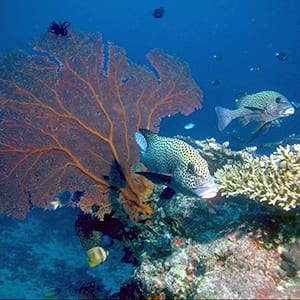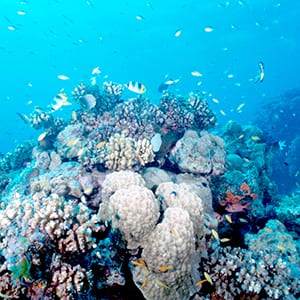Water quality on the Great Barrier Reef the reason for Landholders Driving Change
In response to the ongoing water quality impacts affecting the health of the Great Barrier Reef (GBR), the Queensland and Australian governments have set ambitious targets in the Reef 2050 Long Term Sustainability Plan (Reef 2050 Plan) to reduce pollutants in key reef catchments by 2025 (up to 50% reduction in sediment run-off and up to 80% reduction in nitrogen).
The Queensland and Australian governments also released a new Reef 2050 Water Quality Improvement Plan in July this year that comprises a revised set of catchment targets.
The water quality targets for dissolved inorganic nitrogen, fine sediment (which is measured as total suspended solids), particulate phosphorus and particulate nitrogen provide an unprecedented level of scientific understanding into what is required from the catchments to support Reef health.
The targets are shown for the catchment, region and whole-of-reef scales.
Table 1. Regional water quality targets
| Cape York | MCL | MCL>/td> | 23 | 5 | 14 | 5 | 48 | 5 |
| Wet Tropics | 1700 | 60 | 240 | 25 | 360 | 30 | 850 | 25 |
| Burdekin | 820 | 60 | 890 | 30 | 490 | 25 | 800 | 25 |
| Mackay Whitsunday | 630 | 70 | 130 | 20 | 150 | 20 | 310 | 20 |
| Fitzroy | MCL | MCL | 410 | 25 | 430 | 20 | 760 | 15 |
| Burnett Mary | 470 | 55 | 240 | 20 | 210 | 20 | 590 | 20 |
Queensland local governments are preparing a proposal of priority actions in response to the plans.
The Reef Councils MIP is in the final stages of drafting and will be circulated to all Reef councils for final consultation.
Read the outcomes of the Joint Ministerial Forum here.
As one of its recommendations to address the pollutant reduction challenge, the GBR Water Science Taskforce recommended the implementation of two Major Integrated Projects (MIPs), in each of the Wet and Dry Tropics, to concentrate interventions and management efforts at a catchment scale and fully evaluate their effectiveness in improving water quality.
The MIPs are exploring and testing the efficacy of a more integrated and comprehensive engagement and behavioural change process. They are also piloting land management and repair approaches within selected target catchments, with the aim of developing a self-sustaining package of interventions and tools transferable to other GBR catchments.
Landholders Driving Change is one of those MIPs, concentrating efforts in the Dry Tropics (Bowen, Broken, Bogie (BBB catchment) near Bowen and Collinsville.
Read the Reef 2050 Water Quality Improvement Plan here.
Overarching objectives of the Landholders Driving Change Project
The bulk of fine sediment delivered from the Burdekin River basin to the GBR is derived from a small proportion of the basin area, primarily within the Broken-Bowen-Bogie (BBB) catchments (43%) and Upper Burdekin catchments (27%) with a large proportion of this load from grazing lands.
The NQ Dry Tropics Major Integrated Project – Landholders Driving Change, is focused on engaging with graziers in the BBB catchment to reduce sediment runoff.
The program aims to:
- Achieve knowledge, attitude, skills and aspiration improvements with all land managers in the BBB.
- Increase the capability and capacity to deliver both extension and technical skills and knowledge in the region.
- Increase adoption and implementation of best practices on BBB grazing properties to reduce sediment loss.
- Provide proven, transferable and scalable approaches to improved grazing and land management practices for application in other locations.




